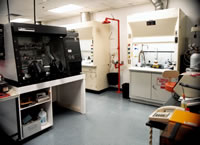
|
FSEC Hydrogen Lab glove box and fume
hood (Photo: S. Spencer) |
|---|
The Hydrogen and Fuel Cell Laboratories at FSEC are constantly expanding research capabilities. The Advanced Energy Research (AER) Division laboratories contain over $1 million of highly specialized scientific chemistry and materials related equipment. These specialized pieces of equipment make the FSEC Hydrogen and Fuel Cell Laboratories one of the nation’s highest caliber research labs of its kind. The equipment is used to conduct hydrogen research on production, storage, utilization and sensors and fuel cell research on membranes, fabrication, mass transport, surface properties and electrochemical diagnostics.
FSEC's AER Division facilities include three fully equipped chemical laboratories comprising 4750 ft2 and a 1300 ft2 field facility. Each of these laboratories is dedicated to a variety of hydrogen and fuel cell R & D programs and activities. Resources available for experiments in these laboratories include:
-
Perkin-Elmer Spectrum 2000 FTIR with Harrick Scientific DRA-2-PE9 diffuse reflectance and HVC-DR2 reaction chamber attachments.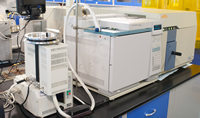
JEOL GCmate-II GC/MS-MS
(Photo: N. Waters)
- JEOL GCmate-II GC/MS-MS with direct injection probe. Its special features include: linked-scan MS/MS for structure determination, high-resolution selected ion monitoring (SIM), programmable temperature heated direct insertion probe with separate ion source chambers for EI and CI operation, NIST/EPA/MSDC mass spectral database, and an automatic bridge to NIST library search routines.
- Varian 3400 gas chromatograph (GC) with automatic injection port.
- Two SRI gas chromatographs equipped with thermal conductivity, flame ionization and flame photometric detectors.
- Dionex IC-1500 Ion Chromatograph/HPLC with AD20 absorbance detector.
- PMI BET surface area measurement unit.
- Three complete thermovolumetric analyzers (TVA). TVAs range in size from 160 mL to 2 L, and are fully automated & operate from a LabView environment.
- Perkin-Elmer, Diamond Thermogravimetric/ Differential Thermal Analyzer (TG/DTA) system equipped with ThermoStar benchtop quadrupole Mass Spectrometer with closed ion source for mass range of 1-300 amu and a detection limit of less than 1 ppm
- Hitachi TM 3000 SEM.
-
Altamira AMI 200 catalyst characterization instrument capable of TPD, TPR, TPO, and TPRx;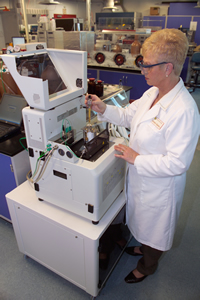
SHIMADZU GC-14B Gas Chromatograph
(Photo: N. Waters) - UV/VIS scanning spectrophotometer.
- IR spectrophotometer.
- Two glove boxes with purification systems that reduce moisture and oxygen to the ppm level and vacuum systems with Schlenk glassware for handling materials under inert conditions.
- SPEX CertiPrep 8000M high-energy ball mill for preparing samples. This ball mill can be used with a variety of vials and has the capability of holding up to four samples simultaneously.
- Fritsch Pulverisette V ball mill capable of monitoring both temperature and pressure during use by way of a data receiver GTM system.
- Perkin-Elmer Spectrum 100 FTIR with Universal ATR Accessory (UATR);
- Hiden Isochema HTP1-V volumetric sorption analyzer (a Sieverts type system – the only unit of its kind in the U.S.) capable of 100 bar/500oC operation;
- Ranson Digital Sonifier 450 W sonicator Model No. 450, EDP: 100-214-239;
- a 1 kW Newport solar simulator Model No. 91190-1000 (equipped with AM1.5 global, AM1.0 & AM0.0 filters);
- Various electrochemical test equipment.
- Induction furnace.
- Assortment of computerized data acquisition and control systems.
- Collection of ovens, autoclaves, AC and DC power supplies and analyzers, and assortment of pumps and balances.
- SHIMADZU GC-14B Gas Chromatograph with thermal conductive and flame ionization detectors.
- Two Lab Alliance High Performance Liquid Chromatographic pumps with maximum flow rate of 100ml/min at 27.5Mpa.
- Zeiss Axio Imager A1 Optical Microscope
- Membrane Electrode Assembly Durability Test Station (MEADS)
- Compact Fuel Cell Test System 850C
- Teledyne Medusa RD
- Fuel Cell Test System 890C
- PAR Potentiostat/Galvanostat Model 263A.
FSEC's computational and modeling capabilities include: Gaussian '03, GaussView, CAChe, AspenPlusTM Chemical Process Simulation (CPS), FACTSage chemical equilibrium, and FLUENT computational fluid dynamics (CFD) platforms.
Research activities in these facilities include:
-
Alternative fuels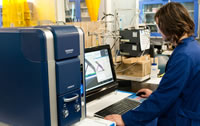
Hitachi TM 3000 SEM
(Photo: N. Waters) - Fuel cells
- High-pressure, high-temperature reactions
- Hydrogen energy systems
- Hydrogen liquefaction and densification
- Hydrogen membrane separation
- Hydrogen production and storage
- Material failure determination
- Material property determination
- Nano synthesis and materials development
- Photo and thermo-catalytic reaction and reactor engineering
- Photocatalytic and photoelectrochemical processes
- Pollutant detoxification
- Sensors and detectors
- Synthesis of metal hydrides and chemical hydrides
- Thermal imaging
- ZBO hydrogen systems
Fuel Cell Facilities
Membrane Electrode Assembly Fabrication – The MEA fabrication facility is used to catalyzed membranes that are employed in both supported and unsupported catalysts for fuel cell applications. The lab is equipped with convection ovens, vacuum ovens, high temperature tube furnaces, and an ultrasonic blender to synthesize the catalytic materials. The fabrication facility has special apparatus for casting polymer membranes, and synthesizing blends and composites, spray stations for spraying the catalyst either manually or an XY table and a screen-printing machine to make membrane electrode assemblies using the decal method. The picture shows a cartoon of a complete PEM fuel cell hardware. Many subscale cell hardware’s are available for cell testing.
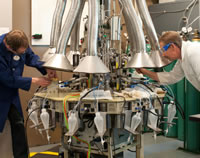 |
Membrane Electrode Assembly Durability Test Station |
|---|
In-Situ Electrochemical Diagnostics - In-Situ Electrochemical Diagnostics is done with a fuel cell test stand, a load box and a frequency response analyzer which comprise a complete fuel cell test station. The tests can be done using 5cm2, and 25cm2 single cell hardware. Current-voltage performance data quantify the decrease in cell voltage with increasing current density. Catalytic activity is measured in mA/mg-Pt, at a cell voltage selected to minimize effects of reactant gas crossover and mass-transport limitation. Current-interrupt measurements that are done include membrane ionic resistance, and contact resistance within, and between, MEA layers.
Membrane reactant crossover rate and ionic resistance are important measures of membrane quality. Hydrogen supplied to the MEA reference electrode permeates the membrane and reaches the opposite electrode at a rate that is measured by the limiting hydrogen oxidation current. Typical rates of reactant crossover are less than 4mA/cm2. The current-interrupt technique and AC impedance spectroscopy measure membrane ionic resistance.
The extent and electrochemical activity of the interfacial area where polymer electrolyte, catalyst, and reactants meet within the electrode, and the electrode permeability to reactant gas, are important measures of electrode quality. Cyclic voltammetry measures the electrochemically-active area, and the electrochemical stability. Hydrogen desorption, or carbon monoxide titration, yield the electrochemically-active interfacial area in m2/g-Pt, which quantifies catalyst utilization. The double-layer charging current yields double-layer capacitance, and can be analyzed to reveal available interfacial area. Current-voltage limiting current data acquired using oxygen, diluted to various extents with nitrogen, or with helium characterize electrode reactant gas permeability, and identify diffusion processes such as Knudsen diffusion within pores, or multi-component bulk diffusion.
Ex-Situ Material Characterization:
At the University of Central Florida’s Materials Characterization Facility (MCF) of the Advanced Materials Processing and Analysis Center (AMPAC) fuel cell material characterization equipment is available. The following characterizations are available: X-Ray diffraction (XRD), transmission electron microscopy (TEM), scanning electron microscopy (SEM) and (EDAX), X-Ray photoelectric spectroscopy (XPS), Auger spectroscopy, differential scanning calorimetry (DSC), thermal gravimetric analysis (TGA) and Fourier transform infrared spectroscopy (FTIR), Leica EMUC7 Ultramicrotome for preperation of semi and ultra thin sections for samples for TEM, SEM, AFM and LM examination.

